‘Little and Lasting is better than Much and Passing’ – Old Moroccan Proverb
 The entire idea of ‘luxury’ revolves around TIME. The craft honed over centuries, hand-made by a painstakingly slow process, to create a timeless product of great beauty that is unique every time, never replicated, such that one never tires of looking at it. The handicraft of every region is an ode to the ingenuity of our species, a manifestation of the inner artist to create beauty from local materials, carefully honed from rudimentary times, passed on down generations. The Zellige tiles of Morocco have a history that goes back more than 1000 years. Even as the craft is dying slowly, there is a resurgence in demand and is currently a rage among the discerning, who are not daunted by its higher cost.
The entire idea of ‘luxury’ revolves around TIME. The craft honed over centuries, hand-made by a painstakingly slow process, to create a timeless product of great beauty that is unique every time, never replicated, such that one never tires of looking at it. The handicraft of every region is an ode to the ingenuity of our species, a manifestation of the inner artist to create beauty from local materials, carefully honed from rudimentary times, passed on down generations. The Zellige tiles of Morocco have a history that goes back more than 1000 years. Even as the craft is dying slowly, there is a resurgence in demand and is currently a rage among the discerning, who are not daunted by its higher cost.
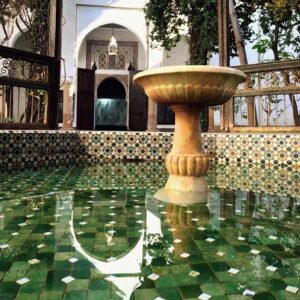
 Walk into the courtyard of Bahia palace in Marrakesh to admire the magic of the Zellige tiles that bring alive the stunning beauty of the fountain. Check out the walls and flooring of the Dar Si Said Museum and be mesmerized. While both these buildings were made in the 19th Century, the first record of Zellige making dates to the 10th Century. Almost as if in response to the arid, dry landscape of Morocco, the crafts persons designed the small geometric shaped Zellige, which make a thousand flowers bloom on the walls and courtyards and everywhere. Soon enough, it became an integral part of Moroccan architecture, mostly used for fountains and lower walls, on minarets and fireplaces. The popularity spread to the neighbors across the Strait of Gibraltar, to Spain and Portugual. It remains the national heritage of Morocco.
Walk into the courtyard of Bahia palace in Marrakesh to admire the magic of the Zellige tiles that bring alive the stunning beauty of the fountain. Check out the walls and flooring of the Dar Si Said Museum and be mesmerized. While both these buildings were made in the 19th Century, the first record of Zellige making dates to the 10th Century. Almost as if in response to the arid, dry landscape of Morocco, the crafts persons designed the small geometric shaped Zellige, which make a thousand flowers bloom on the walls and courtyards and everywhere. Soon enough, it became an integral part of Moroccan architecture, mostly used for fountains and lower walls, on minarets and fireplaces. The popularity spread to the neighbors across the Strait of Gibraltar, to Spain and Portugual. It remains the national heritage of Morocco.
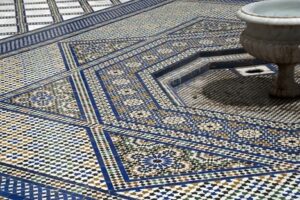
Dar Si Said Museum, Marrakesh
True to the traditions of a craftsperson, the art of making the Zellige tile is handed down from father to son, generation after generation. An apprenticeship for learning the craft is a minimum of ten years. The clay for these terracotta tiles comes from the Fez region of Morocco. It is important that the clay be free of lime or iron to make a perfect Zellige tile. The traditional process is laborious. The clay is soaked in water to soften it. It is then filtered by hand, and manually shaped into individual square tiles and left to dry in the sun. (Naturally, the production is confined to a short seasonal window of Summer, early Fall and Spring}. Next, they are loaded into wood-fired kiln and baked. The traditional kiln design is such that the heat circulates unevenly, which results in different tones of colour. The baked tiles are called Bejmat, which are now glazed in different colours as required. It is fired again to set the enamel. Another craftsman than cuts the tile into shapes required for the Zellige pattern. As a result of the free-hand process, no two tiles are the exact same. It is this imperfection that makes Zellige so beautiful. And different from a ceramic tile.
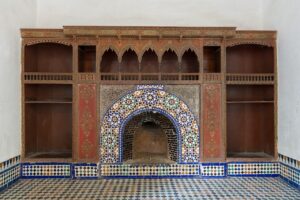 At the recent India Design fair in Delhi, a beautiful Zellige water fountain by Stone Art drew our attention. Also on display were other beautiful crafts from Morocco. Stone Art is bringing these Moroccan beauties to India for its clients. The Founder of Stone Art, Mr Brijesh Bansal, graciously answered our queries.
At the recent India Design fair in Delhi, a beautiful Zellige water fountain by Stone Art drew our attention. Also on display were other beautiful crafts from Morocco. Stone Art is bringing these Moroccan beauties to India for its clients. The Founder of Stone Art, Mr Brijesh Bansal, graciously answered our queries.
Are Zellige tiles made in other places besides Morocco?
The method of creating Moroccan zellige tiles is recognized as a national art form and each artist must attend a special school for artisans in order to perfect their craft. When you choose Moroccan Zellige, you’re supporting a cultural heritage and disciplined art form. The tile-makers take pride in their work and they are passionate about making the very highest quality tiles. No two tiles are exactly alike, and we think that’s what makes them special. Moroccan cities of Fes and Meknes are known as the centers for Zellige. The creation of Zellige is a Moorish art, meaning it was created by the Muslim inhabitants of North Africa and the Mediterranean.
Where are you importing them from?
We are importing this collection from different parts of Morocco, like Fez, Marrakech, and so on. Apart from importing, we are designing these Moroccan inspired center fountains and producing them at our factories in India itself.
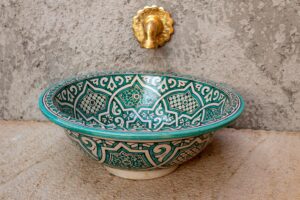
Stone Art, India
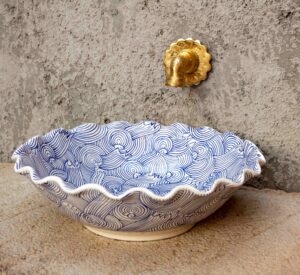
Stone Art, India
Is it possible to customize the water fountain design?
Yes, it is possible to customize the designs of the water fountain with respect to any shape, size, and design. Inspired by the Moorish artisan form of Morocco we are producing customized designs at our factories in the form of Rajasthani inlay work. The ceramic Zellige tiles are replaced by inlay work of marble and semi-precious stones.
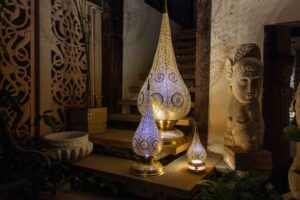
Stone Art, India
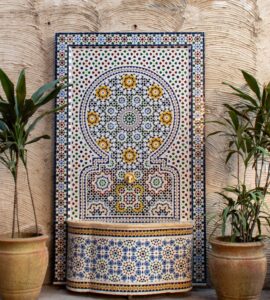
Stone Art, India
Would you be able to provide a similar fountain design using Jaipur handmade tiles? They do look similar in design.
Yes, we can provide a similar fountain design with Rajasthani inlay work of marble and semi-precious stone. The semi-precious stone can be replaced with alternatives to be budget friendly. The fountains look similar in design to quite some extent. Just that the feel of the product varies because the ceramic finish feels more lustrous and smoother while the marble inlay finish is more subtle.
What would be the approximate cost of the Moroccan lamps and water fountain?
The lamps are available in a variety of size, shape and design. The price range starts at Rs. 20,000 and goes up to Rs. 1 lac. The water fountains are available in a variety of sizes, shapes, and intricate designs. The current wall fountain that we have is priced at Rs. 5,00,000. The prices are subject to vary depending on size, shape, and intricacy of design.
